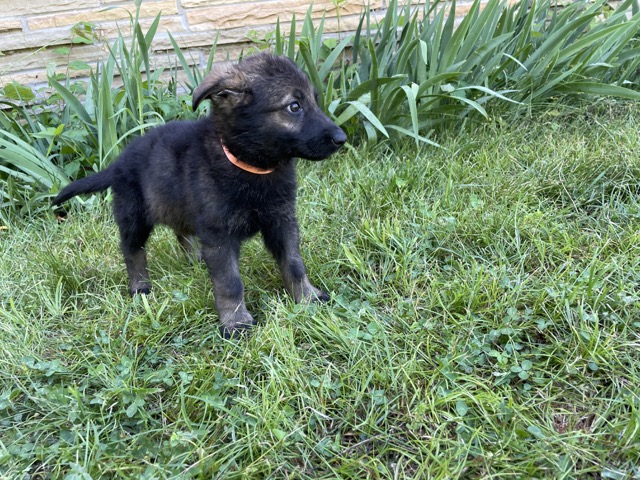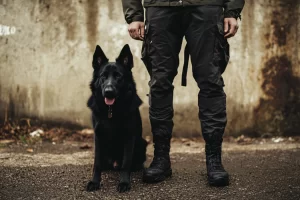Best Practices for Training Your GSD Puppy to Sit and Stay: Updated Strategies
Training your GSD puppy to sit and stay remains a cornerstone of canine discipline and obedience. However, dog training methodologies continuously evolve, informed by new research in animal behavior and positive reinforcement techniques. Here’s an updated guide on the best practices for teaching your puppy to sit and stay, incorporating the latest insights and approaches.
Helping your GSD Puppy Understanding the Importance of Sit and Stay
Commands like “sit” and “stay” lay the foundation for a well-mannered and secure dog. Teaching these commands early on ensures your puppy learns essential self-control and develops good habits that benefit both in everyday interactions and in more complex training scenarios. These commands help prevent unwanted behaviors, foster obedience, and enhance the safety of both your puppy and those around him.
Setting the Stage for Effective Training
Effective training begins with proper preparation. Ensuring your training environment and timing are optimal can significantly enhance your GSD puppy’s learning experience.
1. Consistency: Use the same words for each command (“sit” and “stay”) consistently. Avoid variations that may confuse your puppy.
2. Short Sessions: Puppies have short attention spans. Keep training sessions between 5 to 10 minutes to keep your puppy engaged and responsive.
3. Timing and Environment: Begin in a quiet, distraction-free space. As your puppy’s skills improve, gradually introduce more distractions to strengthen obedience.
4. High-Value Rewards: Use treats your puppy finds irresistible. Alongside verbal praise and petting, this reinforces positive behavior.
5. Use of Clickers: Clicker training remains an effective method. If you opt to use a clicker, condition your puppy by clicking and immediately treating to build a positive association.
Teaching Your GSD Puppy the Sit Command
1. Positional Guidance: Start with your puppy standing in front of you. Hold a treat close to their nose, allowing them to sniff but not take it.
2. Luring to Sit: Slowly move the treat upwards and slightly back over their head. This movement encourages your GSD puppy to sit as they follow the treat with their nose.
3. Marking the Behavior: The moment your puppy’s bottom touches the floor, say “sit” clearly, click (if using a clicker), and immediately reward with a treat and verbal praise.
4. Repetition and Reinforcement: Repeat these steps several times during short sessions. Puppies learn through repetition and reinforcement.
5. Phasing Out the Lure: Once your GSD puppy reliably sits with the lure, transition to using only the hand signal. Perform the same upward motion with an empty hand, say “sit,” and reward compliance.
Introducing Your GSD Puppy the Stay Command
Once your GSD Puppy can sit reliably, you can begin teaching “stay.” This command is more complex as it involves duration and impulse control.
1. Starting from Sit: Have your puppy sit in front of you. Stand close initially to minimize distractions.
2. Cue and Treat: Extend your hand with a flat palm facing your puppy while clearly saying “stay.” After a brief moment (one or two seconds), reward with a treat and verbal praise if your puppy remains in place.
3. Increasing Duration: Gradually increase the duration your puppy must stay before receiving the treat. Start with three seconds, then five, ten, and so forth.
4. Adding Distance: Once your puppy understands “stay,” start taking small steps back while giving the command. Begin with one or two feet, gradually increasing the distance. Always return to your puppy before giving the treat and praise.
5. Introducing Distractions: As your puppy’s “stay” becomes more reliable, introduce mild distractions, such as soft noises or toys. Gradually increase the level of distractions while rewarding your puppy for maintaining the stay position.
6. Release Command: Choose a release word like “okay,” “free,” or “release” to indicate the end of the stay period. Consistently use this word and reward your GSD puppy for breaking the stay on cue.
Troubleshooting Common Issues
During training, your GSD puppy may encounter some common issues. Here’s how to address them:
1. Breaking the Stay Too Soon: If your puppy frequently breaks the stay command before being released, reduce the duration or distance and build it up again gradually.
2. Ignoring the Sit Command: Ensure that you’re using high-value treats and training in a distraction-free environment if your puppy isn’t responding.
3. Inconsistent Responses: Make sure all family members use the same commands and reward system to avoid confusion.
4. Losing Interest: Keep sessions short and exciting with frequent rewards if your puppy seems bored or unmotivated.
Advanced Tips for Sit and Stay
Here are some advanced strategies to enhance your training:
1. Variable Rewards: Introduce variable rewards as your puppy becomes proficient with the commands. Combine treats, praise, and favorite toys to maintain their motivation.
2. Generalization: Practice commands in diverse environments to help your puppy generalize the behaviors. Train in different rooms, backyards, during walks, and at the park.
3. Proofing: Gradually increase the complexity of training scenarios to ensure your puppy responds reliably. Practice commands during busy family gatherings or around other dogs.
4. Command Combinations: Teach more complex training sequences by combining commands. For example, a “sit-stay-come” sequence enhances your puppy’s obedience and responsiveness.
5. Emergency Commands: Train an emergency sit or stay command that your puppy obeys instantly, regardless of distractions. This can be crucial in high-risk situations, such as near traffic or other dangers.
Long-Term Maintenance of Good Behavior
Training is an ongoing process. Here’s how to sustain good behavior over time:
1. Regular Practice: Incorporate training into your daily routine for continuous reinforcement. Short, frequent sessions are more effective than long, sporadic ones.
2. Positive Reinforcement: Continuously use treats, praise, and rewards to reinforce good behavior. Even as your puppy grows, occasional rewards keep training enjoyable.
3. Consistency and Patience: Ensure everyone in the household uses the same commands and rewards. Consistency is vital for your puppy’s understanding and obedience.
4. Adapt and Evolve: As your puppy grows, adapt your training techniques to suit their changing needs. Continue to challenge them with new commands and complex sequences.
Final Thoughts
Training your puppy to sit and stay is a vital step in their development. These commands foster a sense of trust, strengthen your bond, and ensure their safety in various situations. While the process requires time, patience, and dedication, the results are immensely rewarding. By incorporating these updated best practices, you lay a strong foundation for all future training endeavors, ensuring a harmonious relationship with your beloved canine companion.
In conclusion, understanding and integrating these new approaches and data-driven practices into your training regimen can immensely benefit both you and your puppy. Embrace this journey with enthusiasm, and you’ll find that the bond you build with your dog through effective training is both profound and enduring. We at Czech Working Line are committed to continuing to bring you more articles of this caliber. Feel free to email with questions.




